Exam (elaborations)
TEST BANK: INTRODUCTION TO CLINICAL PHARMACOLOGY 9TH EDITION BY VISOVSKY| All Chapters Covered| Download for Grade A+
- Course
- Institution
- Book
TEST BANK: INTRODUCTION TO CLINICAL PHARMACOLOGY 9TH EDITION BY VISOVSKY| All Chapters Covered| Download for Grade A+| Chapter 01: Pharmacology and the Nursing Process in LPN Practice Chapter 02: Legal, Regulatory, and Ethical Aspects of Drug Administration Chapter 03: Principles of Pharmacology...
[Show more]



